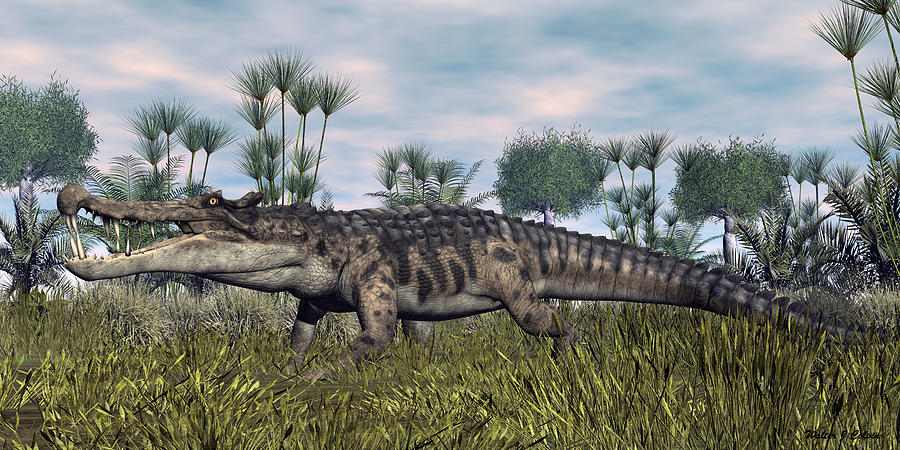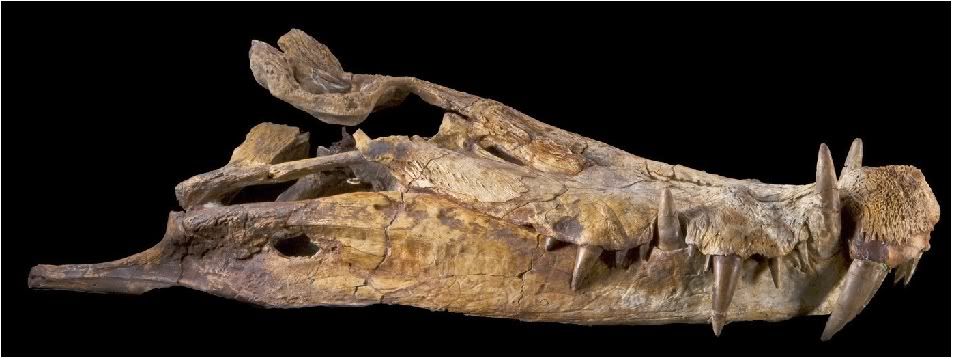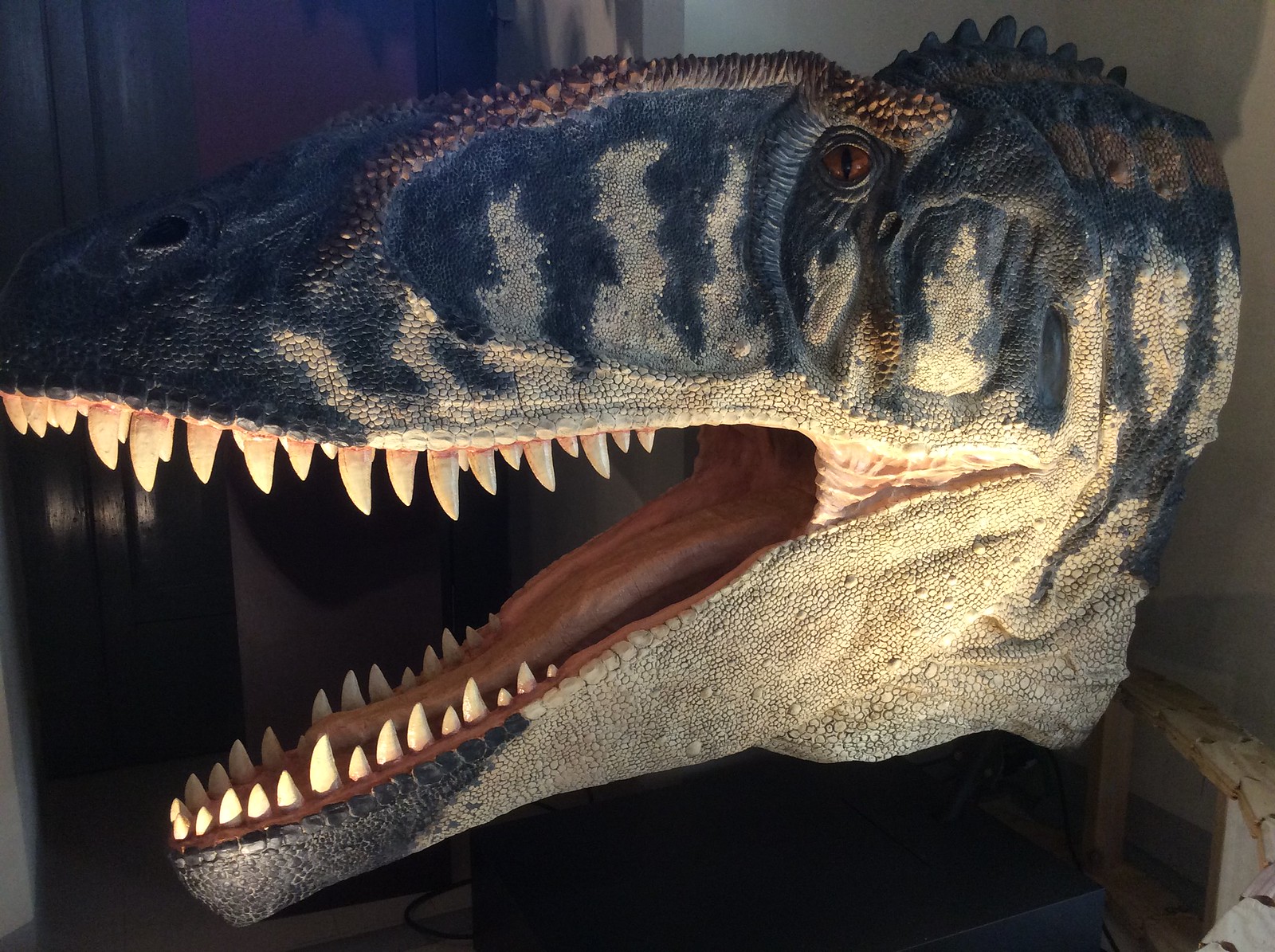Carcharodon
Junior Member
  Allosauroidea Enthusiast
Allosauroidea Enthusiast
Posts: 211
|
Post by Carcharodon on Dec 22, 2013 5:36:46 GMT 5
Kaprosuchus saharicus
Kaprosuchus is an extinct genus of mahajangasuchid crocodyliform. It is known from a single nearly complete skull collected from the Upper Cretaceous Echkar Formation of Niger. The name means "boar crocodile" from the Greek kapros ("boar") and souchos ("crocodile") in reference to its unusually large caniniform teeth which resemble those of a boar. It has been nicknamed "BoarCroc" by Paul Sereno and Hans Larsson, who first described the genus in a monograph published in ZooKeys in 2009 along with other Saharan crocodyliformes such as Anatosuchus and Laganosuchus. The type species is K. saharicus. Kaprosuchus is known from a nearly complete skull in which measured 50 cm long, whilst the entire animal is estimated to have been around 3-4 metres (10-13 feet) in length. It possesses three sets of tusk-like caniniform teeth that project above and below the skull, one of which in the lower jaw fits into notches in upper jaw. This type of dentition is not seen in any other known crocodyliform. Another unique characteristic of Kaprosuchus is the presence of large, rugose horns formed from the squamosal and parietal bones that project posteriorly from the skull. Smaller projections are also seen in the closely related Mahajangasuchus. The snout of Kaprosuchus shows generalized proportions and the naris is positioned dorsally. In Kaprosuchus many teeth are hypertrophied and labiolingually (laterally) compressed, unlike those of crocodyliforms with similarly shallow snouts, which are usually subconical and of moderate length. Another difference between the skull of Kaprosuchus and those of crocodyliforms that also possess dorsoventrally compressed snouts is the great depth of the posterior portion of the skull.

Dimetrodon grandis
Dimetrodon was a predatory synapsid genus that flourished during the Permian period, living between 280–265 million years ago (during the Artinskian to Capitanian stages). Dimetrodon had a high, arched, flat structure running along the length of its back. This feature is presumed to have been used by the animal for regulating body temperature, for example by absorbing the warmth of sunshine. Because the structure looked something like a ribbed sail, this kind of long-extinct creature is sometimes informally referred to as a "sail-back dimetrodon". Dimetrodon was one of the largest land animals and the apex predator of its time. Different types of dimetrodons ranged in length from 90 to 400 centimetres (35 to 160 in) and weighed between 14 and 300 kilograms (31 and 660 lb). Its diet could have included freshwater sharks, amphibians, reptiles and other amniotes. In particular, there is evidence the amphibian Eryops and freshwater shark Xenacanthus were its prey. Fossilized leg bones of Eryops and skulls of Xenacanthus were found to have teeth marks matching the shape of the teeth of Dimetrodon. Dimetrodon probably relied primarily on its sight and smell to hunt.
 |
|
|
|
Post by Godzillasaurus on Dec 22, 2013 5:44:21 GMT 5
Kaprosuchus practically crushes dimetrodon's skull if it can't cause enough bodily or neck damage already.
|
|
|
|
Post by Runic on Dec 22, 2013 8:27:08 GMT 5
Dimetrodon actually seems like it can bite down and control kaprosuchus skull in the fight.
|
|
|
|
Post by Infinity Blade on Dec 22, 2013 19:29:37 GMT 5
I'm assuming parity, so I'd say 50/50, I don't see how one has much of an advantage over another unless Dimetrodon didn't have what it takes to crunch through crocodyliform armor.
|
|
Carcharodon
Junior Member
  Allosauroidea Enthusiast
Allosauroidea Enthusiast
Posts: 211
|
Post by Carcharodon on Dec 22, 2013 20:20:50 GMT 5
Dimetrodon had quite a robust skull and imo had a pretty powerful bite, so i'd say it should be capable of biting through the neck osteoderms of a crocodylomorph, although i think this would be rather more difficult to do so with kaprosuchus due to those rugose horns on its head.
|
|
|
|
Post by Godzillasaurus on Dec 22, 2013 20:27:15 GMT 5
Dimetrodon had quite a robust skull and imo had a pretty powerful bite, so i'd say it should be capable of biting through the neck osteoderms of a crocodylomorph, although i think this would be rather more difficult to do so with kaprosuchus due to those rugose horns on its head. It didn't have horns... And still, kaprosuchus in general appears to have been perfectly adapted for crushing, so it would likely have no problem doing so here |
|
|
|
Post by Runic on Dec 22, 2013 20:36:46 GMT 5
Dimetrodon had quite a robust skull and imo had a pretty powerful bite, so i'd say it should be capable of biting through the neck osteoderms of a crocodylomorph, although i think this would be rather more difficult to do so with kaprosuchus due to those rugose horns on its head. It didn't have horns... And still, kaprosuchus in general appears to have been perfectly adapted for crushing, so it would likely have no problem doing so here Dimetrodon had robust dentition as well so one could assume it was a crusher aswell. |
|
Carcharodon
Junior Member
  Allosauroidea Enthusiast
Allosauroidea Enthusiast
Posts: 211
|
Post by Carcharodon on Dec 22, 2013 20:42:13 GMT 5
Dimetrodon had quite a robust skull and imo had a pretty powerful bite, so i'd say it should be capable of biting through the neck osteoderms of a crocodylomorph, although i think this would be rather more difficult to do so with kaprosuchus due to those rugose horns on its head. It didn't have horns... And still, kaprosuchus in general appears to have been perfectly adapted for crushing, so it would likely have no problem doing so here Kaprosuchus did have rugose horns projected posteriorly on the skull:  |
|
|
|
Post by Godzillasaurus on Dec 22, 2013 20:55:07 GMT 5
They were not real "horns" though. Horn-like structures, but not real horns.
|
|
|
|
Post by spinodontosaurus on Dec 23, 2013 15:04:06 GMT 5

I don't think it is Kaprosuchus that will be doing the face munching if I'm honest, not when Dimetrodon has a head and teeth like those. The Dimetrodon is scaled after a 48 cm skull that was supposedly estimated at 250 kg and 3.2 meters. The full body skeletal I used fits that length estimate, and is clearly the bigger of the two here. Kaprosuchus would be what, ~ 180 kg?
Although the D. grandis is the largest known specimen, there are others that are very close in size (e.g. one with a 46 cm skull), so I don't think it's an abnormal specimen or anything.
I think Kaprosuchus' best hope would be to try and exploit the more sluggish (I assume) posture of Dimetrodon - although being rather low-slung and slow itself this isn't hugely likely imo.
Dimetrodon grandis wins. |
|
Deleted
Deleted Member
Posts: 0
|
Post by Deleted on Dec 23, 2013 15:21:55 GMT 5
It actually seems like Dimetrodon can intimidate the Kaprosuchus with it's sail or just overpower it.
|
|
|
|
Post by creature386 on Dec 23, 2013 16:03:03 GMT 5
After seeing this comparison, I gotta have to give my vote to Dimetrodon.
|
|
|
|
Post by Infinity Blade on Dec 23, 2013 18:46:41 GMT 5
Even without the sail, Dimetrodon looks bulkier from lateral view and has just as an impressive head, if not even more, not to mention probably overall heavier. The synapsid beats the diapsid.
|
|
Carcharodon
Junior Member
  Allosauroidea Enthusiast
Allosauroidea Enthusiast
Posts: 211
|
Post by Carcharodon on Dec 23, 2013 19:31:16 GMT 5
Looking at the size comp, dimetrodon should win here.
|
|
Deleted
Deleted Member
Posts: 0
|
Post by Deleted on Dec 24, 2013 17:54:37 GMT 5
Mismatch, Kaprosuchus was only the size of an American Alligator
|
|
















